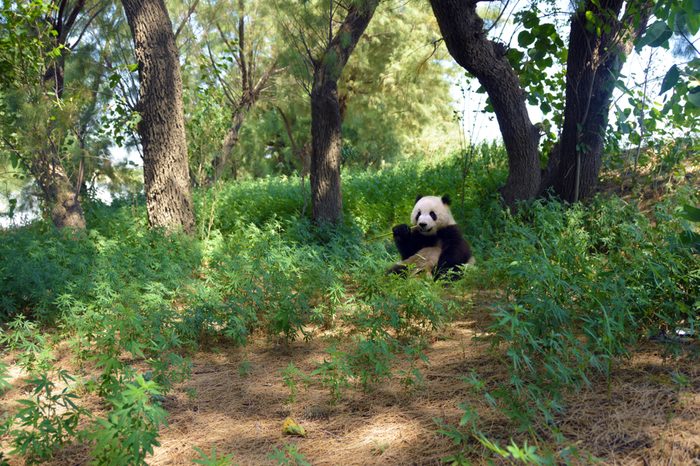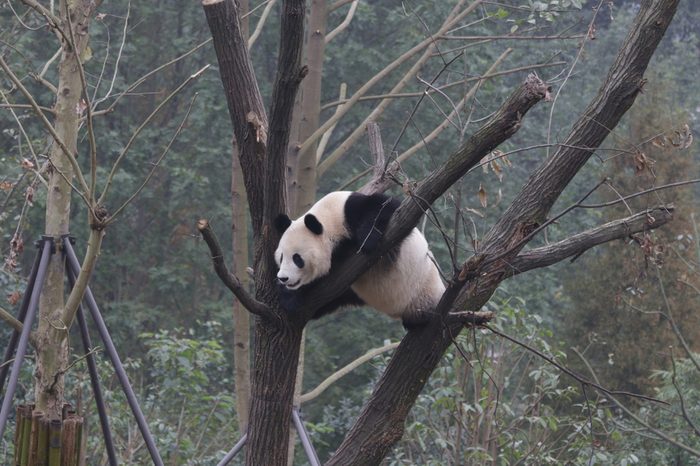Because who doesn't want to know more about the most adorable animals on the planet?
13 Panda Facts That Will Make You Love Them Even More

Panda Fact #1: Pandas have huge growth spurts
Pandas grow from tiny to massive in a few short years. Pink, blind, and hairless, panda infants weigh just three to five ounces and have been compared in size to a stick of butter. But within a year, pandas tip the scales at around 100 pounds; fully mature pandas can be up to six feet long and reach 350 pounds. This isn’t one of the only panda facts that will surprise you, there are a lot of panda facts that the average person doesn’t know!

Panda Fact #2: Pandas eat a lot of bamboo
We can’t talk about panda facts without mentioning their love of bamboo. Giant pandas are technically carnivores, but their diets consist nearly exclusively of bamboo. Because the plant lacks much nutritional value, pandas eat up to 85 pounds of bamboo a day to maintain their energy levels and can scarf down a shoot in about 40 seconds. (Don’t worry, their throats have a special lining to protect against splinters.) But all that fiber has side effects: An adult panda can produce more than 60 pounds of droppings in 24 hours.

Panda Fact #3: Pandas have six fingers on each paw
Unlike other members of the bear family that have little or no dexterity in their paws, pandas have opposable “thumbs,” along with five other fingers, that help them hold bamboo and remove the plant’s stems and leaves before eating. Like these panda facts? Check out these 23 “facts” about animals that just aren’t true.

Panda Fact #4: Pandas are native to China
These cuddly creatures are found in central China, specifically in Sichuan, Shaanxi, and Gansu provinces. According to the panda facts from the Smithsonian’s National Zoo, they once lived in lowlands but had to relocate to bamboo forests in the mountains because of farming and forest clearing.

Panda Fact #5: Pandas can be dangerous
Sure, panda facts are usually light-hearted and fun but don’t be misled by the cute faces and cuddly-looking fur. These bears could not only crush you with their heavy bodies, but they also have very strong teeth and jaw muscles that they use to crush tough bamboo. Don’t miss these innocent-looking animals that are surprisingly dangerous.

Panda Fact #6: Pandas don’t hibernate
Pandas don’t settle down for a winter slumber like most other bears. Instead, they head down the mountains where they live to find warmer temperatures. Other panda facts make these animals different from most bears, including the fact that pandas aren’t carnivorous.

Panda Fact #7: Pandas love their naps
Instead of sleeping through the night, wild pandas take naps after eating that last two to four hours. In the summertime, they can nap for six or more hours. They don’t care about the position they sleep in, either. They can snooze on their backs, sides, or bellies; curled up in a ball; or all sprawled out. Hopefully our panda facts won’t put you to sleep!

Panda Fact #8: Pandas value alone time
Adult pandas don’t spend much time interacting with each other, and they’re generally quiet animals. However, they do occasionally communicate through scent marks, squeaking, barking, growling, or huffing.

Panda Fact #9: Pandas play an important role in their habitat
Pandas love all the bamboo available in their forest homes, but they also have a crucial role in the forest’s ecosystem by spreading seeds that encourage vegetation growth. This helps ensure the forests’ other residents, like multicolored pheasants, blue dwarf sheep, and the endangered golden monkey, also have a suitable home. Check out more animals that have unexpected superpowers.

Panda Fact #10: We may finally know why pandas are black and white
For years, scientists speculated as to why panda fur is colored the way it is. One belief was that it helped them camouflage in forests of bamboo and in the snow, and another suggested that it helped them maintain appropriate body temperature since black absorbs heat and white reflects it. But in 2017, a study published in the journal Behavioral Ecology claimed that the camouflage theory is in fact correct, stating that the white fur helps the animal hide in snowy habitats while the black fur is used for camouflage and communication. The study authors believe their black ears are a sign of aggression toward predators and the black fur around their eyes helps them identify other pandas.

Panda Fact #11: Some pandas don’t know how to have sex
Giant pandas may be unknowingly contributing to their place on the endangered species list. Female pandas are able to mate only two or three days per year, and some males don’t know how to do the deed. Tian Tian and Mei Xiang, a pair of pandas who live together at the National Zoo in Washington, DC haven’t naturally conceived a cub in 13 years. Says David Wildt, the head of the Center for Species Survival at the zoo, “Rather than pulling Mei Xiang toward his lap, Tian Tian steps on her back and stands there like a man who has just opened a large box from IKEA and has no idea what to do next.”

Panda Fact #12: The United States pays big bucks to rent pandas from China
Zoos in just four U.S. cities—Atlanta, Washington, DC, San Diego, and Memphis—house giant pandas, and they pay a hefty rental fee to the Chinese government. According to the New York Times, American zoos generally pay $1 million a year in fees as part of a typical ten-year contract.

Panda Fact #13: Pandas may soon be endangered
Rounding off our panda facts is this sad reality. Although they don’t have many natural predators, there are only about 1,800 pandas left in the wild, the World Wildlife Fund estimates. Their conservation status is “vulnerable,” just one step above “endangered.” The primary factors for this status are poaching and loss of habitat due to the construction of roads and railroads. Luckily, organizations like the World Wildlife Fund are putting all hands on deck to preserve their habitats and keep pandas around for years to come. After learning these panda facts, get inspired to donate to WWF or other conservation organizations that help these 11 other wild animals you never realized were endangered.


















